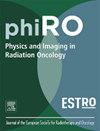Investigating the potential of diffusion tensor atlases to generate anisotropic clinical tumor volumes in glioblastoma patients
IF 3.4
Q2 ONCOLOGY
引用次数: 0
Abstract
Background and purpose:
Diffusion tensor imaging (DTI) has been proposed to guide the anisotropic expansion from gross tumor volume to clinical target volume (CTV), aiming to integrate known tumor spread patterns into the CTV. This study investigate the potential of using a DTI atlas as an alternative to patient-specific DTI for generating anisotropic CTVs.
Materials and Methods:
The dataset consisted of twenty-eight newly diagnosed glioblastoma patients from a Danish national DTI protocol with post-operative T1-contrast and DTI imaging. Three different DTI atlases, spatially aligned to the patient images using deformable image registration, were considered as alternatives. Anisotropic CTVs were constructed to match the volume of a 15 mm isotropic expansion by generating 3D distance maps using either patient- or atlas-DTI as input to the shortest path solver. The degree of CTV anisotropy was controlled by the migration ratio, modeling tumor cell migration along the dominant white matter fiber direction extracted from DTI. The similarity between patient- and atlas-DTI CTVs was analyzed using the Dice Similarity Coefficient (DSC), with significance testing according to a Wilcoxon test.
Results:
The median (range) DSC between anisotropic CTVs generated using patient-specific and atlas-based DTI was 0.96 (0.93–0.97), 0.96 (0.93–0.97), and 0.95 (0.93–0.97) for the three atlases, respectively (p 0.01), for a migration ratio of 10. The results remained consistent over the range of studied migration ratios (2 to 100).
Conclusion:
The high degree of similarity between all anisotropic CTVs indicates that atlas-DTI is a viable replacement for patient-specific DTI for incorporating fiber direction into the CTV.
探讨扩散张量图谱在胶质母细胞瘤患者中产生各向异性临床肿瘤体积的潜力。
背景与目的:提出利用弥散张量成像(Diffusion tensor imaging, DTI)引导肿瘤体积向临床靶体积(clinical target volume, CTV)的各向异性扩张,将已知的肿瘤扩散模式整合到CTV中。本研究探讨了利用DTI图谱替代患者特异性DTI生成各向异性ctv的可能性。材料和方法:数据集包括28名来自丹麦国家DTI方案的新诊断的胶质母细胞瘤患者,术后进行t1对比和DTI成像。三种不同的DTI图集,使用可变形图像配准在空间上与患者图像对齐,被认为是替代方案。构建各向异性ctv,以匹配15mm各向同性扩展的体积,通过生成3D距离图,使用患者或atlas-DTI作为最短路径求解器的输入。通过迁移率控制CTV各向异性的程度,模拟肿瘤细胞沿DTI提取的白质纤维优势方向迁移。采用Dice相似系数(DSC)分析患者与atlas-DTI ctv之间的相似性,并根据Wilcoxon检验进行显著性检验。结果:三个地图集的各向异性cvs中位(范围)DSC分别为0.96(0.93-0.97)、0.96(0.93-0.97)和0.95 (0.93-0.97)(p > 0.01),迁移比为10。在研究的迁移比率(2到100)范围内,结果保持一致。结论:各向异性CTV之间的高度相似性表明,atlas-DTI是将纤维方向纳入CTV的患者特异性DTI的可行替代品。
本文章由计算机程序翻译,如有差异,请以英文原文为准。
求助全文
约1分钟内获得全文
求助全文
来源期刊

Physics and Imaging in Radiation Oncology
Physics and Astronomy-Radiation
CiteScore
5.30
自引率
18.90%
发文量
93
审稿时长
6 weeks
 求助内容:
求助内容: 应助结果提醒方式:
应助结果提醒方式:


